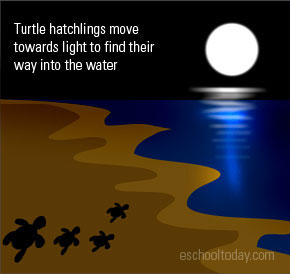- Light Pollution
Light pollution and hatchlings sea turtles
 Sea turtles live in water. When mature female turtles are ready to lay eggs, they come over to the sandy shore and find a dark place to lay their eggs. They dig a shallow hole in the sand, bury the eggs there, and return to the ocean.
Sea turtles live in water. When mature female turtles are ready to lay eggs, they come over to the sandy shore and find a dark place to lay their eggs. They dig a shallow hole in the sand, bury the eggs there, and return to the ocean.
Florida beaches in the USA are known for their high sea turtle population.
After incubating for about two months, the eggs are hatched, and the hatchlings turtles stay beneath the sand until the temperatures and conditions are right to come out.
With the right conditions, they wave their way onto the surface in the night and move to the ocean with the help of natural lights reflecting on the sea. Baby sea turtles naturally, move towards moonlight reflection in the hope of getting into the ocean.
Unfortunately, our beaches are full of artificial lights from beach houses, car parks, and security lights. As a result, the baby sea turtles are deceived and move towards these artificial lights. Many of them are harmed and killed before they find their way to the ocean.
Egg-laden turtles need dark quiet sandy beaches to lay their eggs, just as the hatchlings also depend on natural skylights to guide them to the waters. There are bound to be disorientations when we flood our beaches and nearby living areas with bright artificial lights.
